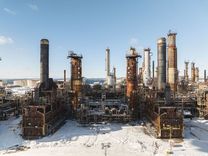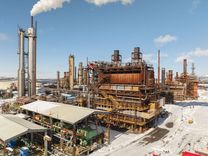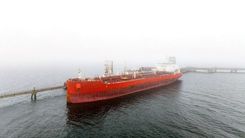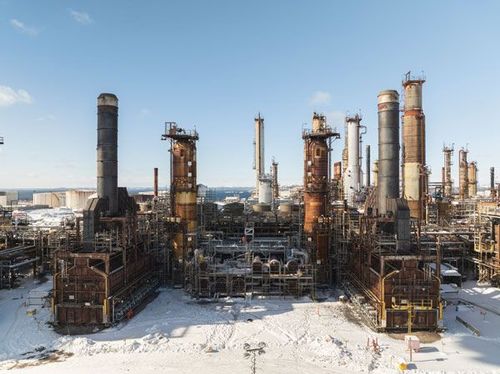Jumping at the Chance




The new and refurbished Come by Chance Refinery, a renewable diesel plant in Newfoundland, Canada, achieved commercial operations in February. PHOTO: BRAYA RENEWABLE FUELS
June 5, 2024
BY Katie Schroeder
Calling Braya Renewable Fuels’ Come by Chance Refinery a unique facility would be an understatement. Located on the island of Newfoundland, Canada, in a town called Come by Chance and situated on one of the few deep water harbors in North America, there is a long list of factors that make the facility stand out.
Built in the 1970s, the 135,000-barrel-per-day Come by Chance Refinery was converted from a petroleum refinery to a renewable diesel (RD) facility in 2023, starting RD production this past February. Cresta Fund Management purchased a majority stake in that the facility in November 2021, well aware of its many distinctive attributes. Chris Rozzell, managing partner of Cresta, explains how the company recognized the incredible potential the facility held for a conversion. When the COVID-19 pandemic hit, the facility was shuttered and became unprofitable. “They imported most or all their crude from distant markets, putting them at a disadvantage to other North American refineries,” Rozzell says. “It was very expensive, and ultimately they just weren’t able to operate profitably.” John Skrinar, a partner at Cresta, had a preexisting relationship with the prior owners—who are still minority owners—and knew that with Cresta’s focus on the low-carbon molecule, the refinery made an ideal candidate for conversion to renewable fuel production.
Braya’s Come by Chance Refinery is positioned at the crossroads of maritime Atlantic trade routes, allowing the facility to easily access feedstock from North America, South America and Europe, explains Todd O’Malley, CEO of Braya. “We have the ability to take various feedstocks, again because of our geographic location, [which is] kind of a corner of regular trade routes throughout the Atlantic Basin. [This includes] soybean oil, used cooking oil, tallow, other waste fats and distillers corn oil, and we bring them in by vessel ... and ultimately run them through the facility to manufacture renewable diesel, and then load that diesel out to oceangoing vessels,” he says.
One of the structural factors that made this facility a great option for a conversion project was its huge hydrocracker, Rozzell explains. “The refinery was already configured to make diesel and jet, so we did not have to convert, for example, a naphtha unit into a diesel unit, which other people have had to do,” he says. “It also had a highly skilled, unionized workforce that, in some cases is multigenerational. We have people who are the third generation of their family working at this facility, and that [history] was very attractive to us.” A significant portion of the refinery’s preexisting workforce stayed with the facility through the conversion, and Braya employs most of its staff locally in Come by Chance.”
All of Braya’s feedstock is shipped in by tanker, and all of the fuel is shipped out the same way. Railcars and trucks are not a viable transportation option for the facility because of its island location. However, access to feedstocks via ship has helped keep the carbon intensity (CI) score of Braya’s RD low due to efficient transport, O’Malley explains..
Having feedstock shipped in has also advantaged Braya’s profits despite the decrease in renewable identification number (RIN) values under the U.S. Renewable Fuel Standard, according to Rozzell. That profitability allows for Cresta’s potential to expand to buy some of the struggling biodiesel plants across the U.S. “We see these cyclical industries move up and down because of the way they’re designed,” he says. “When prices are low, facilities shut in. When facilities shut in, we run out of product and prices go up. So, this could be an investment time for us.”
Converting to Renewable
The process of conversion was fairly straightforward, Rozzell explains. One of the main changes that needed to be made to produce RD was replacing the existing catalyst that was intended for refining crude oil with one that handles fatty acids such as animal fats and vegetable oils. “We’ve chosen Haldor-Topsoe as our partner,” he says. “Their catalyst is very flexible, it’s very efficient, and you can take a wider range of feedstocks. That flexibility is very important when you’re thinking about long-term operations.”
One of the challenges faced by Braya in the conversion was the overall impact of COVID on the supply chain. This was coupled with the spike in nickel prices and supply chain issues caused by Russia’s invasion of Ukraine, impacting Braya’s purchase of new steel piping. “The nickel market went a little crazy the past couple of years because Russia is one of the larger exporters of nickel in the world, so that created some supply chain challenges,” Rozzell says.
The newly installed pipes also need to be constantly heated because the biobased feedstock may gel up in a way that crude oil does not. In an area where temperatures can sink to negative 20 degrees Celsius, electrical heat tracing and robust insulation was vital. O’Malley also emphasizes the importance of ensuring that employees are not exposed to the brutal temperatures and 40 mile-per-hour winds. “A close partnership with the technology providers and engineering firms that we use, as well as having that highly experienced local knowledge workforce, allowed us to work through and overcome any issues that did arise,” he says.
Advertisement
Challenges such as unexpected costs or extra work needed to bring the facility up to date regarding safety infrastructure were handled with resilience and flexible financing. Overall, startup of the facility in February went well, and the plant was able to operate at its current capacity within 30 days, according to Rozzell. In spite of challenges in the conversion process, he sees Braya as worth the effort. “It’s one of a kind—we could never build another Braya,” he says. “There is no other facility in the world that has its unique combination of logistics and scale advantages.”
A Future for SAF
Less than three years after Cresta gained ownership, the facility now produces up to 18,000 barrels per day of renewable diesel and SAF. Currently, Braya does not sell SAF, instead leaving it in with the renewable diesel for sale. “In today’s market, it’s not that profitable to make SAF, and the [customers] of SAF are executing offtake agreements, but they are buying very small amounts,” Rozzell says. “So, we just need a bigger market. But our firm believes that in the long term, all of this product will ultimately become SAF. I don’t see any other alternatives for the airlines. They’re not going to put batteries in 777s—it’s just not happening.”
The catalyst used in the facility makes around 70%-80% RD and 20%-30% SAF; however, these percentages could be flipped with a “moderate follow-on investment,” Rozzell explains. One of the short-term goals that the company plans to pursue is increasing the percentage of SAF to roughly 40%, which involves installing separate tanking infrastructure to divide the SAF and RD product streams.
When that future arrives, Braya is ideally located to easily transport fuel to New York Harbor, going from Come by Chance to New York City’s La Guardia and JFK airports in only a couple of days. All the fuel produced at Braya’s refinery is currently exported internationally. O’Malley explains that this is partially due to Canada’s market dynamics, regulatory environment and the Coasting Trade Act in Canada, which requires ships selling into Canada to be Canadian made and staffed, as well as flying a Canadian flag. “I would anticipate that as the CFR continues to develop in Canada, that there will be incremental opportunities for us to supply Canadian markets,” O’Malley says.
Advertisement
Thinking Ahead
Moving forward, one near-term goal is to get the plant running beyond its current 18,000 bpd capacity. Rozzell explains that the hydrocracker is capable of processing 41,000 bpd and, with some investment, that volume is achievable. The limiting factor in maximizing production capacity is hydrogen. “We don’t produce enough hydrogen to run at full capacity,” he says. “We’re looking at either restarting some of the other refinery units to help create more hydrogen or building out [green] hydrogen [infrastructure].” Braya is involved in assessing the potential of a green hydrogen project that would utilize Newfoundland’s excellent wind resources and abundant hydropower to increase the amount of hydrogen available and decarbonize the refinery’s processes.
Green hydrogen is not the only decarbonization strategy that Cresta plans to explore. Rozzell references a variety of technologies that could serve as alternatives to fuel gas and boilers, which would help reduce the carbon intensity of Braya’s products. “Our priorities right now are primarily tactical,” he says. “For example, let’s get the plant to full capacity and reduce our carbon intensity as much as possible. Then, we can move to the more strategic areas such as horizontal or vertical expansion.” Investment in aggregation and logistics to streamline the feedstock pipeline are two vertical expansion strategies that have been considered, Rozzell explains.
An exciting development for the industry that Rozzell recognizes is the opportunity to use the GREET model in the U.S. for evaluating the CI of RD and SAF. This opens up many feedstock options, he says. “The regulators seem to understand that if we create artificial barriers to producing SAF, we just will likely never have enough feedstock available to make a serious impact.”
As governments’ attention shifts away from fossil fuel-derived hydrocarbons and toward a net-zero future, Cresta’s and Braya’s leadership hopes that the facility can serve as an example of what’s possible in the energy transition. “The main goal at the end of the day is to be a leader, and I think a blueprint for future facilities around the world,” O’Malley adds. “This is in terms of how we can transition a very difficult but critical segment of the global economy from traditional petroleum fuels to drop in RD and SAF, and do it at world class scale—safely, reliably and environmentally responsibly.”
Author: Katie Schroeder
Katie.schroeder@bbiinternational.com
Upcoming Events





